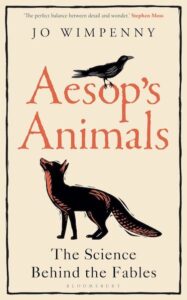 The Tortoise and the Hare.
The Tortoise and the Hare.
The Wolf in Sheep’s Clothing.
The Ants and the Grasshopper.
I would be astonished if you, like millions upon millions of people over the past two and a half millennia, have not heard of these stories by the ancient Greek fabulist Aesop. And I hope you can even re-tell them if asked to do so by a curious child, or perhaps by person who has not been so fortunate as to have had them read to him or her at such an age.
However have you ever wondered about the biological questions these fables inspire? The respective speed and levels of endurance found in tortoises and hares? The ability of wolves to be deceptive? The planning and food acquisition strategies of ants and grasshoppers?
In her new book Aesop’s Animals; The Science Behind the Fables, Dr. Jo Wimpenny employs nine of Aesop’s famous fables to lead her readers down some truly enlightening paths about animal physiology, ethology, cognition, and a number of other interesting topics. The most recent addition to the Bloomsbury Sigma Science collection, my reading thus far of the first few chapters has already shown me that it is very much worthy of the commendable aspirations of that series to bring new and dynamic authors to a broad audience.
Available from:
If you enjoyed reading this, please consider signing up for The Well-read Naturalist's newsletter. You'll receive a helpful list of recently published reviews, short essays, and notes about books in your e-mail inbox once each fortnight.

